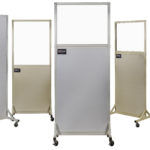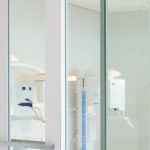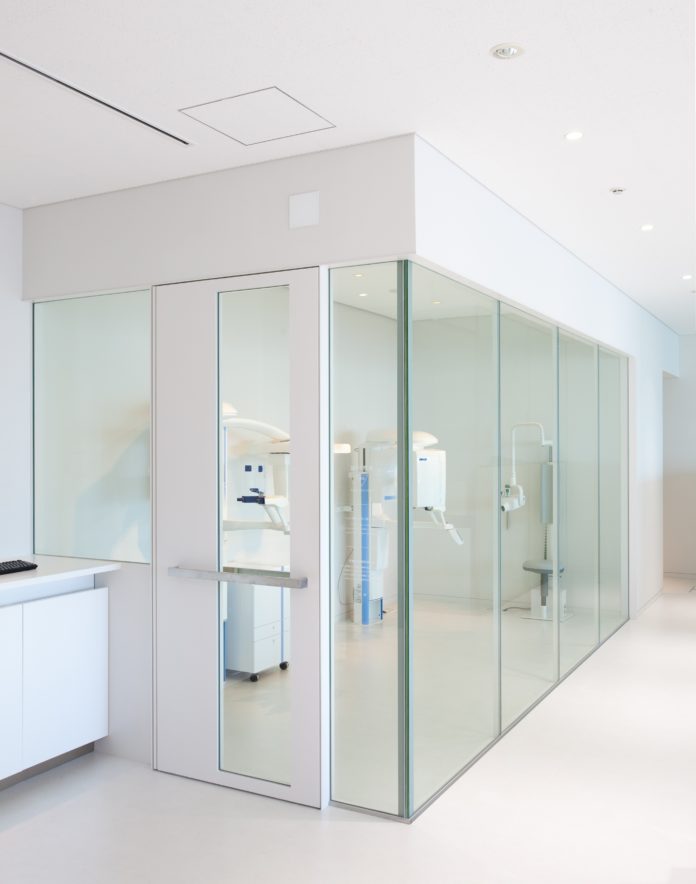By Paul Rochus Sponsored Content
In the last article I wrote on radiation shielding materials, I explored the factors considered by a shielding materials expert when designing radiation shielding. Lead, tungsten and concrete are all very effective forms of shielding that have their advantages and disadvantages, but one downside is these materials are not transparent. Two common and reliable solutions to provide safe shielding; lead X-Ray glass or clear lead acrylic. Both materials are used in variety of application, from windows in NDT Rooms, to small windows on tungsten vial shields. While lead glass is typically more economical than acrylic, both are materials that a shielding materials expert would consider when presented with the challenge of creating transparent radiation shielding.
Material Composition
Leaded Glass and Leaded Acrylic both contain forms of lead in the material. Leaded Glass contains over 60%wt of heavy metal oxide with 55%wt being lead monoxide (PbO). Leaded acrylic contains at least 30% by weight of an organolead compound. Both in the glass and acrylic, enough lead compounds are added to maximize shielding while keeping the material clear and transparent.
Gamma Attenuation and Lead Equivalencies
When comparing the attenuation of lead glass and lead acrylic, it is often best to compare it to the equivalent amount of lead to provide the same shielding. Below, in the tables, you can see different lead equivalences of standard thickness of lead glass and lead acrylic. Comparing Lead Glass and Lead Acrylic, generally 5x the thickness is needed and when comparing weight, Lead Acrylic is 1.8x heavier for the same shielding benefits.
 Clarity
Clarity
Both lead glass and lead acrylic are transparent materials. Lead acrylic tends to have a slight tint to it, while lead glass is perfectly clear. Over time, lead acrylic may start to darken due to exposure to ultraviolet light or chemicals. Lead Glass is resistant to chemicals and does not darken due to UV light, however, lead glass will darken over time when expose when exposed to ionizing radiation. The refractive index of leaded acrylic is lower than lead glass, which means that lead acrylic is less reflective than lead glass and will have less of a glare on the surface. Lead glass will allow more light to pass through.
Durability
 Generally, lead acrylic is easier to ship because of it is less likely to break when moved. It can be shipped laying flat and be stacked as well. Lead glass is fragile and therefore needs to be shipped on an edge and it cannot be stacked. This also means that special precautions need to be followed when installing a glass panel. To produce shatter resistant glass, lead glass is available laminated with protective sheet glass on one or both sides. Impact and shatter resistant laminated glass like SAF-T-LITE (shown in the image above) and LX Premium are very common options when designing shielding that will be moved around like mobile barriers or doors. Because of the added layers of laminated material, 11 mm of SAF-T-LITE has the same lead equivalency to 7 mm of regular lead glass.
Generally, lead acrylic is easier to ship because of it is less likely to break when moved. It can be shipped laying flat and be stacked as well. Lead glass is fragile and therefore needs to be shipped on an edge and it cannot be stacked. This also means that special precautions need to be followed when installing a glass panel. To produce shatter resistant glass, lead glass is available laminated with protective sheet glass on one or both sides. Impact and shatter resistant laminated glass like SAF-T-LITE (shown in the image above) and LX Premium are very common options when designing shielding that will be moved around like mobile barriers or doors. Because of the added layers of laminated material, 11 mm of SAF-T-LITE has the same lead equivalency to 7 mm of regular lead glass.
When comparing the two materials resistance to scratches, acrylic has a soft surface and is more prone to scratching, but shallow scratches can be polished out if done properly. Lead glass is hard and resistant to scratches. Another factor to consider when comparing durability is the materials resistance to flames and chemicals. Lead acrylic will burn and release toxic fumes if exposed to flames whereas lead glass does not burn. Lead glass is more resistant to chemicals than lead acrylic, especially safety glass with the laminated protective layers.
When looking for a transparent material to shield from ionizing radiation, lead glass or lead acrylic are two reliable solutions. High quality glass or acrylic with provide excellent transparent shielding and that can be used in barriers, window, doors and even medical isotope vials. If you would like to find out more information about lead glass or acrylic, you can find in on the MarShield website or you can contact MarShield directly, and we help you find the best radiation shielding solution for you.


